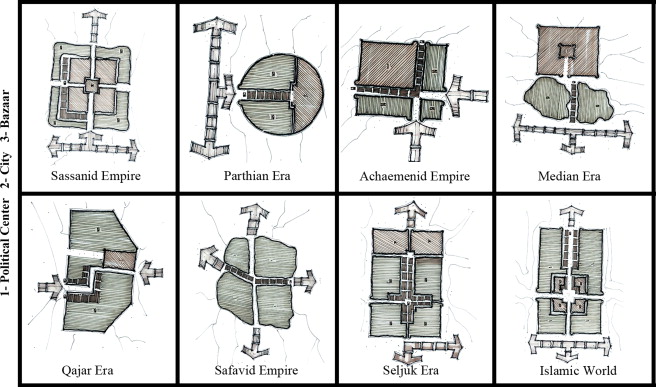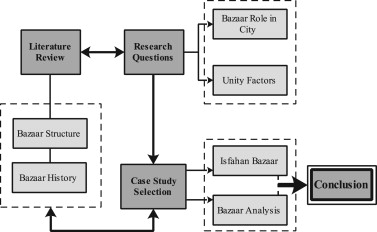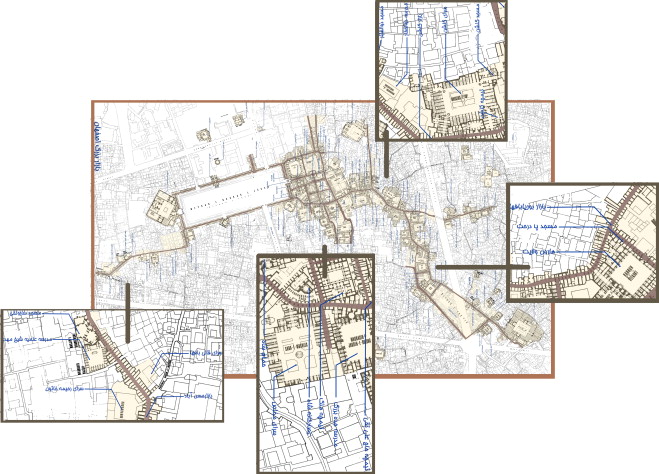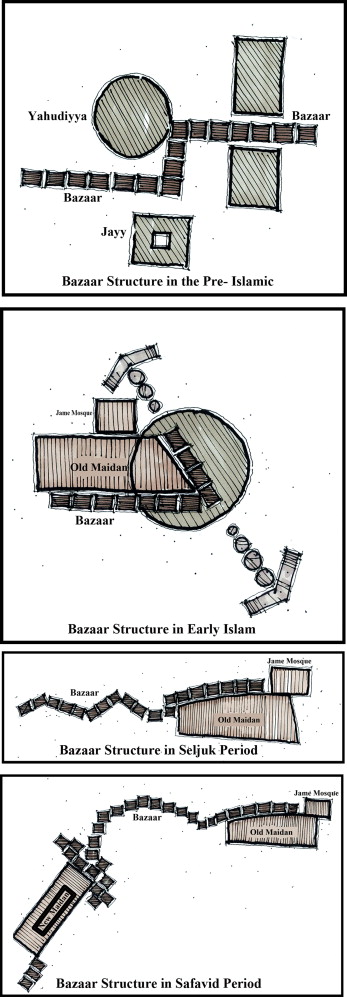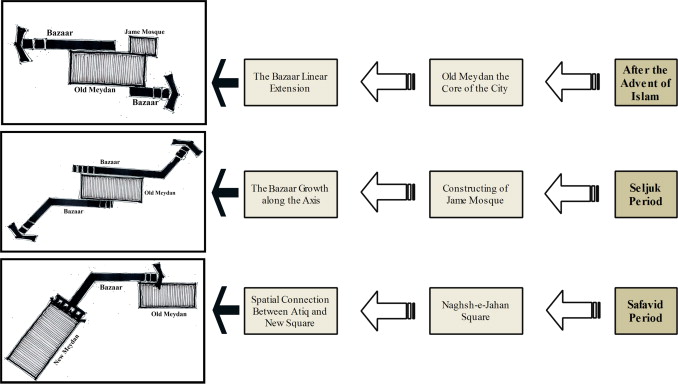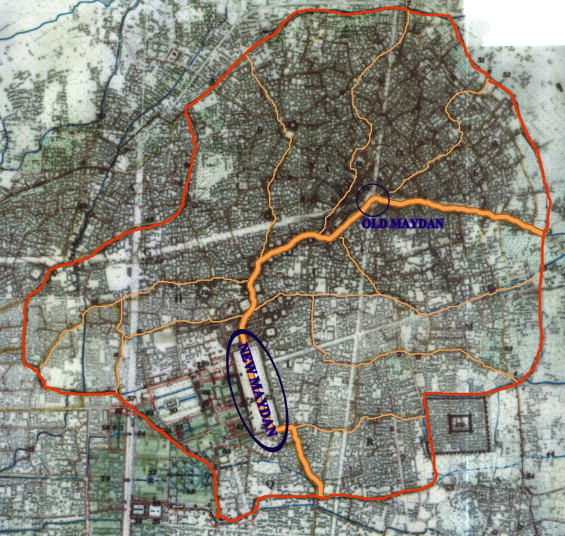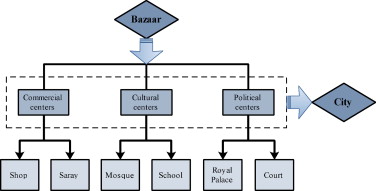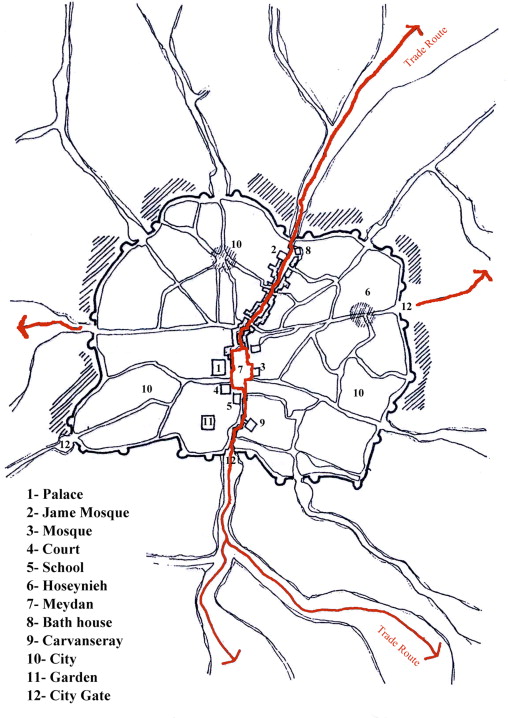Abstract
A city is a vital organism that lives and grows like other organisms. Therefore, implementing development plans that would provide a sense of unity and integration in relation to the city as a whole is necessary. Traditional Iranian architecture is full of samples evolved during the course of Iranian history that can serve as architectural paragons of the city. In Irans traditional cities, a sense of unity exists in various urban areas. The traditional city of Isfahan is one of the most valuable samples and was selected as the case study in this research. Accordingly, the most important questions of this research are as follows: (1) What is the role of bazaars in creating a sense of unity in the traditional cities of Iran? (2) How do bazaars play out their role in the integration of these cities?
This research focuses on the concept of a “traditional city” to determine the role of bazaars in such cities. The results show that bazaars are crucial in giving a sense of integrity to the concept of a traditional Iranian city. Bazaars provide cohesion among the different parts of cities, such as residential areas, as well as socio-political and trade centers. This condition means that traditional bazaars play two important roles in traditional cities: (1) they interconnect the different parts of the citys physical structure; and (2) the crucial role of bazaars in a citys social and cultural structure brings about unity among the citizens in the city. Bazaars as a unifying element connect the main urban functions and guarantee the citys economic and social life.
Keywords
Traditional city ; Bazaar ; Development axes ; Isfahan
1. Introduction
“In the early 1970s, Odum, 1971 ; Odum, 1973 proposed that flows of energy and materials in societies can be analyzed in the same way they are analyzed in organisms and ecosystems” (Samaniego and Moses, 2008 ). As such, a city is a vital organism that lives and grows like other organisms, and its life is dependent on a series of factors. A city that has political aspects might be able to change the destination of a nation. Hence, political systems and knowledgeable management are needed. A city is also a center for research about human behavior enabling researchers to determine the suitable culture for the next generation. From a city managers viewpoint, cities and urban places can be regarded as valuable technological, artistic, cultural, and social achievements in different centuries (Danesh and Tayyebi, 2011 ). The role of cities has been increasingly considered as a critical part of the global economy (Fanni, 2006 ). Cities and residential complexes are the most visible manifestations of human culture that provide perceptual and objective spaces for presenting the most intellectual and subjective components of life (Danesh, 2010 ). Thus, scholars and researchers believe that a city develops and define its stages with phrases such as “the shaping and appearance stage”, “transformation stage”, and “the emergence of a new concept of city development”. This observation shows that all of the citys attributes somehow have analogs in living organisms. Therefore, a city is an organism that needs an underlying structure, such as a backbone, to secure its different elements around itself and enable their natural and logical development.
Towns, cities, and residential areas are the most prominent manifestations of human culture (Jamalinezhad et al., 2012 ). Georges Marcais described the physical organization of city markets as ordered in a certain hierarchy that is only partly accidental (Abu-Lughod, 1987 ). A bazaar is one characteristic factor of cities in different historical periods, which makes a citys social and economic life a sign of progress or backwardness. Sometimes, a bazaar is the center of protest and riots against the government or political system and determines the destiny of a society. Since the early days of civilization and urbanization in Iran, bazaars have been present in cities and have become a factor in the exchange of culture between civilizations. This scenario means that societies develop cultural exchange by the direct exchange of goods (Masoudi Nejad, 2007 ). Bazaars, as the backbone and economic heart of Iranian cities, include primary and secondary linear circulation spaces called “Rasteh”, open and closed spaces, indoor and outdoor spaces, beautiful arches, skylights, and karbandies along the fixed axis or multiple branches (Rajabi and Sefahan, 2009 ). The role of bazaars in Iranian cities is very important; Isfahan is a historical city that has a particular role in Irans history, whose bazaar was formed over the centuries (Mojtahedzadeh, 2012 ). The study of the Isfahan bazaar can show all structural principles of historical Iranian bazaars. It reveals a bazaars role as an institutor and integration factor in the different periods of Iranian history. The organization of Iranian traditional cities has changed during the different eras. In the Median era, a city was a fortress on a hill or other strategic points. In the Achaemenid era, a city became a trade center for the first time. The general plan of a city was a circle in the Parthian era. In the 7th century and the Islamic ages, a mosque was the main urban space, and the city was formed around it. In the Safavid era, a city was changed to an agricultural, industrial, and commercial center that the government supervised.
2. Literature review
2.1. Bazaar structure in an Iranian city
A bazaars role in a typical Iranian city is very important. The word “bazaar” is an old Persian word that is now an integral part of Iranian culture. The word has a very long history, and historical documents indicate that the concept of a bazaar in Iranian towns and cities dates back to 3000 B.C (Kermani and Luiten, 2009 ). The study of urban history reveals that a variety of factors have influenced the development of ancient cities. The economy has always been one of the most important factors in urban growth. In a traditional city in Iran, the bazaar has been a place for the economic, social, political, cultural, and civic activities of people (Moosavi, 2005 ). In fact, a bazaar is one of the key elements of spatial organization in Iranian cities; the main body of the city cannot be defined without the existence of a bazaar. In many historical cities, the main transport routes are established in relationship to the main “Bazaar Rasteh”; hence, historical bazaars are in the form and layout of cities (Pourjafar et al., 2013 ). A crucial idea states that the structure of traditional cities in Iran is based on its bazaars economic and political factors. From early Iranian urbanization to the present time, different factors have been crucial in the formation of traditional cities. This composition has had its own form in each period, and the governors complete this combination to show their strength and wisdom. Some scholars believe that bazaars are the main core of Islamic cities; others consider the “Jame mosque” as the city center; whereas some believe both are Islamic city concepts (Encyclopedia Islamica, 2012 ). The most prevalent depiction of an Iranian bazaar privileges generalized cultural factors. This long-standing literature views bazaars as constituting a holistic way of life encompassing economic forms, political sensibilities, social relations, and various ideological persuasions, all of which fall under the rubric traditional (Keshavarzian, 2009 ). Iranian markets in urban areas have a significant cultural and social role in their economic function (Pourjafar and Pourjafar, 2011 ).
Iranian bazaars were the center of virtually all economic activities. They linked the rural areas with local and regional urban consumer markets and integrated the provincial cities into the modern industrial sectors (Rotblat, 1975 ). A bazaar also provides bridges between the middle and lower classes of Iranian society (Mazaheri, 2006 ). A bazaar is considered as one of the most significant socio-spatial systems in Iranian cities based on in Iranian urban studies (Masoudi Nejad, 2007 ). The structure of Iranian traditional cities reveals that a bazaar, which usually takes a linear shape, acts as the spinal column of the city and continues toward the main gates of the town (Assari et al., 2012 ). A bazaar is thus located in the main core of Islamic and Iranian cities. An Iranian city is frequently defined by a congregational Jame mosque and must have a chief bazaar nearby. For economic and commercial activities in Iranian cities, the bazaar is the most important public space.
2.2. Bazaars in different historical periods of Iran
Bazaars exist, as they always have, as meaningful entities. When we speak of a bazaar, we should already know where and what it is (Keshavarzian, 2009 ). In a Median city, the bazaar was still in its embryonic stage and its building was primary; but the castles and internal divisions were carefully planned and designed (Habibi, 2008 ). In this period, the city was a place to show the reign of power and reflect financial strength. Bazaars have not yet completely emerged. With the emergence of money in the Achaemenid Empire, the city became the center of government, trade, and economics; the bazaar was thus born in Persian cities for the first time (Habibi, 2008 ). In the Parthian era, the bazaar was considered as the area along the main road from the city gate to the downtown (Soltanzadeh, 1983 ).
Bazaars served as the backbone of towns in the Sassanid period. A bazaar began from the citys downtown, continued to faubourg, and shaped the neighborhoods along its path. The bazaar was the heart of the city, and the plaza connected to the bazaar changed into a place for socio-economic activities (Habibi, 2008 ). Historically, the Sassanid era was the most important one. This era saw the emergence of an urbanization system in the form of Sharestan, which included Kohandege (the towers and bulwarks of the town) and quarters and alleys (bazaar, entrance gates, residential districts of ordinary people, and the royal zone) in the Shahrestan area of Isfahan (Salehi et al., 2012 ). The bazaar emerged in this era in its present form and is the place where each trade product sold or produced is localized in a particular section (Keshavarzian, 2009 ). In the Islamic world, the city was divided into three districts: Sharestan (middle city), Kohandege (outside city), and Rabaz (bazaar) (Soltanzadeh, 1983 ). The Jame mosque, Madrasah (religious school), Caravansary, and bathhouses are among the numerous public spaces built in the middle city (Heidari, 2012 ). The bazaar in the early Islamic era was designed in the Sassanid method (Saraie, 2011 ). In this period, bazaars were important for city formation and structure. A number of factors played decisive roles in shaping the form of an Iranian city. In general, these factors included the following: natural laws, religious and cultural beliefs, as well as social and economic principles (Saoud, 2002 ). The main span of a bazaar opened to a grand plaza and spread its branches to the city. The citys neighborhoods are arranged around this complex according to their social, economic, and cultural position (Habibi, 2008 ). In the Safavid Empire, the Jame mosque, bazaar, political and social centers, and residential spaces created an integrated complex, each with its own personality in the hierarchy of urban spaces (Soltanzadeh, 1983 ) (Figure 1 ).
|
|
|
Figure 1. Bazaar structures in different periods. |
Overall, an Iranian bazaar begins from one of the city gates and continues in one wide strip to other gates on the other side of the city. Different public buildings, such as the mosque, school, and bathhouses (as well as residential neighborhoods) form along the bazaar route (Assari et al., 2011 ). In this period, bazaars had an active role in city life.
3. Inference mechanism
3.1. Theoretical framework
Study and literature reviews show that a city is an organism with both physical and spiritual aspects. It has both subjective and objective concepts. Cities are full of life, so a desire to know the structure of a city and what unifies its various parts exists. What is the structure of a city and what constitutes its backbone? Studies have proven that bazaars play an important role in the life and integral structure of a city.
The main contribution of this research is to enhance the condition of all valuable architecture and urban design heritages of Iranian bazaars. It also aims to derive certain urban design criteria for the design development of civic centers in new expansion areas of existing and future towns. The main structures and integral architectural components of a bazaar have been determined and further elaborated based on the Isfahan bazaar (Fig. 2 ).
|
|
|
Figure 2. Research process based on previous studies. |
3.2. Research questions
- What are the integral architectural components of Iranian bazaars? What role does each of these components play in relation to an Iranian city?
- How do bazaars play out their role in the integration of these cities?
3.3. Research method
Figure 3 , Figure 4 , Figure 5 , Figure 6 ; Figure 7 Based on these research questions, our paper proposes to use the historical-interpretation research method. It uses analytical-description techniques, data collected from field studies, and library documents.
|
|
|
Figure 3. Different areas of the Isfahan bazaar. |
|
|
|
Figure 4. Architectural elements of the Isfahan bazaar. |
|
|
|
Figure 5. Structural evolution of the Isfahan bazaar in diffrent historical periods. |
|
|
|
Figure 6. Architectural elements of the Isfahan bazaar. |
|
|
|
Figure 7. Bazaar development in the old Isfahan. |
3.4. Case study selection
Isfahan is a very old city that has a significant role in Iranian history. It is the Iranian city par excellence. During its hundred years of evolution, the city has become one of the most appreciated cities in the world (Karimi and Mohamed, 2003 ). Situated between the Masjid-i-Jai and the Maydan-i-Shah at a distance of several kilometers, Isfahan is dotted with minarets, mausoleums, mosques, and bazaar areas that served the trade needs of the central plateau of Persia. These structures were built over the intervening centuries. The old town began to gradually expand back in Sassanian times, and some of the small clusters of the bazaar still remained as satellite villages under Shah Abbas' reign. His genius formed the new city, and his conception linked the new with the old (Bakhtiar, 1974 ). Isfahan is one of the oldest centers of civilization in Iran. It is also thought to be among greatest cities in the world with regard to its architecture and historical treasures. It is also favored by nature. Isfahan was once the seat of the Persian government and is currently the center of intellectual and religious life, the locus of economic activities, and the dwelling place of a large segment of those engaged in these urban functions (Jayyusi et al., 2008 ). For all these reasons, a study on Isfahans traditional bazaars can be a representative of all historical and traditional bazaars in the different periods and places of Irans history.
4. Isfahan bazaar
4.1. Importance of the Isfahan bazaar
Commerce is an ancient economic system that enables the establishment of legal and ethical foundations. It can strengthen social ties and improve cultural relationships that include increased trading values, technology, and goods (Edgu et al., 2012 ). Isfahans location, nearly midway between the two great emporia of Damascus and Aleppo in the west and Samarqand and Bokhara in the east, made it a historical center for the exchange of goods and ideas between the eastern and western parts of the Islamic world. Its central position in Iran also preconditioned it to become the capital of two major dynasties, the Seljuk (1037–1157) and the Safavid (1502–1736) dynasties. Its dual functions as an emporium and as a capital manifested in bazaars and in the courtly buildings that gave Isfahan the reputation of an oriental Versailles (Jayyusi et al., 2008 ). Given the geographical position of Isfahan at the center of the Iranian plateau, it has been known as one of the most important trade centers of Iran. This position occasionally makes it the bridge between the East, West, South, and North. Its bazaar has developed in the parts of the city that are closely connected with producers and customers.
Studies show that the development of Isfahan began from the Shahrestan (Jayy) and Yahudiyya quarters. The primary Isfahan Bazaar was built alongside the royal palace and the Jame mosque. With the establishment of the Bazaar, Isfahan turned itself into a commercial city. The bazaar in this period, especially from the second century onward, has been one of the major elements of most trading cities and of even some larger villages (Shafaghi, 2001 ). The Isfahan bazaar has unique scientific values so that anyone can find the citys identity through it. Bazaars are never static because cities continue to live and grow around their significant axes.
4.2. Architectural elements of bazaars
Urban sociologists, urban planners, and urban designers generally depict a bazaar as the heart of an Iranian city (Masoudi Nejad, 2007 ). On a socio-economic level, a bazaar is only partly a retail cluster, although its main part is composed of retail. The Isfahan bazaar is a unified, self-contained building complex of shops, passageways, and “Caravanserais”, interspersed with a square (Meydan), religious buildings, bathhouses (Hammam), and other public institutions. A spatial structural analysis of the Isfahan bazaar and its transformation through time shows that it has a linear structure, and many of its spatial elements are formed around the central axis. Among all the main buildings around the bazaar, the Atiq mosque and Naghshe Jahan square are the more important places at the beginning and end of the bazaar axis. The former is a symbol of religious affairs, whereas the other is a symbol of worldly affairs. Both structures have been characterized as symbols of the citys power and majesty at a particular stage of the citys boom.
Moghadasi, a famous historian in the tenth century, described a bazaar as a long street with some roofed and non-roofed quarters. In contrast, the Isfahan bazaar extension is surrounded by an integrated complex of various elements in its overall structure. The primary elements of the bazaar are the “Dokkan” (shop), “Hojreh” (small shop), “Rasteh” (bazaar street), “Tim”, “Timcheh”, “Qaysariye”, “Chaharsouq”, “Saray”, and “Caravanserai”. The secondary elements are the “Madrasah” (schools), “Masjid” (mosques), “Hammam” (bathhouse), and “Assarkhaneh”. The main axis of the bazaar is the “Qaysariye”, with the two important elements of the kings house and the “Zarrabkhane” (mint building). Most of the “Sarays” in the bazaar are double-storied so that the second floor has a continuous porch overlooking the courtyard.
These elements around the Isfahan bazaar are vital and essential to the functional buildings of urban life. Therefore, a bazaar is not merely the commercial center, but also plays an essential religious, cultural, social, and political role in the city. Other urban activities such as the residential quarter surround this part of the city, supplying the citizens' daily needs.
4.3. Evolution of the Isfahan bazaar
Isfahans origins rest in the twin cities of Yahudiyya and Jayy, at a short distance from one another on the plain north of the Zayanderood River. The Jewish town of Yahudiyya flourished in the first centuries of Islam and became the hub of Isfahan. Jayy was established to the southeast of Yahudiyya as an administrative center (Mari, 2006 ). Jayy was a fortified site that may have functioned as the center of government, whereas Yahudiyya was the commercial center (Goodson et al., 2010 ). Existing plans of the ancient city show that the bazaar was situated between Yahudiyya and Jayy. After the Muslim conquest of Iran, the Arabs built their first Jame Mosque in the region of Isfahan in Jayy. By the next period, the bazaar was constructed in the direction of Yahudiyya. The city could then be described as having the Jame Mosque in the center of the bustling bazaar, which was visited daily by large crowds of people with wares from kingdoms both near and far.
The nucleus of Safavid planning was once again a meydan because this was the ideal layout to unify the most important functions of the city as the administrative, religious, intellectual, and economic center of the region. However, what had been developed at the old meydan in the course of centuries was now recreated in a planned way. Behind the arcades running around the meydan, bazaar lines with shops and workshops to the east, west and south existed. The northern edge of the square was lined with coffee houses, whose upper floors were used as hotels and brothels.
Research findings show that the transition at the Isfahan bazaar and its evolution from a simple bazaar to a completely developed complex was not accomplished within a specific period, but over several centuries. In the fourth century, many major Islamic cities had large bazaars. The history of the Isfahan bazaar, however, date back to the period before the advent of Islam, and its evolution can be examined as an illustration of a singular complex. Hence, the Isfahan bazaar was formed in line with the main streets of the city. The bazaar is divided into two types of expansion: Organic and designed. The main parts of the Isfahan bazaar have been formed organically and evolved naturally. The other parts of the bazaar were designed by the best and most famous architects and urban designers of the era.
5. Discussion and conclusion
5.1. Bazaar position in the citys physical structure
The main element of the city of Jayy is a small bazaar located in the northern part of the present city. After the Islamic conquest, the Arabs constructed a large bazaar in the northwest region of Yahudiyya, and a Jame mosque was built in this region. In early Islam, the core or backbone of the city (along the North–South axis) was the Silk Road that ran through the middle of the city. At the base of the city structure was the intersection of two main communication axes. At the point of intersection, the direction of one of these axes was altered, and a new meydan was made. In the Seljuk era, the Jame mosque and the palace were formed within this core and the bazaar, as a strictly linear element, extended from two sides of the core and along the main axis. During the Safavid period, the king decided to move his court away from the old city. He set up Naghshe Jahan square as the central core of his plan in the southwest margin of the city, and tied the old meydan at Naghshe Jahan square with shops that extended the city along this axis. With the connection of the new bazaar around the Naghshe Jahan square and the old bazaar alongside the Atiq square, the invigorated socio-economic life of the city continued. In the next period, residential neighborhoods formed around the bazaar that became the heart and spirit of the town.
Overall, it may well be concluded that over many centuries, Isfahan bazaar had three major developmental steps. First of all, after the advent of Islam in Iran, the old meydan of the city was built and the bazaar formed around it, connecting the main parts of the city to each other. In the second phase, the bazaar organically grew around the old meydan and the Jame mosque. Finally, in the third phase, the bazaar developed linearly between the old and new meydan and so citizens built their homes along this new axis.
5.2. Bazaar position in physical structure of the city
The bazaar complex generally includes other buildings, such as the religious Madrasah, educational centers, Saghakhaneh, and mosques. These famous centers in the city are formed around the bazaar axis and complete the bazaar structure. Most of the religious, political, social, and cultural activities of the city that guarantee the citys survival are located in this direction and determine the citys development axis. The bazaar space is influenced by its integrated segments; it is not only allocated to traditional affairs, but also full of magnificent Persian palaces.
Hence, the primary core of Isfahan city is located near the crossroad of the communication line and the trade route that is Isfahan bazaar. After the Arab conquest, the Jame mosque was laid alongside the bazaar, and the political and socio-cultural centers, as well as the royal palace, were all concentrated around the bazaar. The bazaar also provides the material and spiritual aspects of the city, does not make distinctions between urban spaces, and forms an integrated and unified complex with links to the different areas of the city. When Isfahan reached the peak of its prosperity in the Safavid era, the bazaar connected the old and new cities and ensured the survival and well-being of the city.
In the traditional city of Isfahan, the bazaar was a place of economic, social, political, cultural, and civic activity of the people. Just as blood vessels distribute energy and materials to cells in an organism, the Isfahan bazaar distributes facilities, goods, people, and liquidity throughout the urban area. The bazaar, surrounded by a number of commercial, socio-religious, and political buildings, has no residential function at all. Thus, it unifies the vital functions of Isfahan city, including the residential areas. The old Isfahan bazaar is the main commercial center and forms the hub of the city. Finally, any Iranian city cannot be imagined without its economic center and bazaar. It provides the material and spiritual life of the city and does not distinguish between them, forming a distinct and unified urban space. The bazaar passes through the mosque as a holy center and other practical public spaces. It also creates the ongoing dynamic of the city and improves the quality of the citizens' life.
5.3. Conclusion
The collection of the economic, social, religious, and main cultural centers of the traditional Iranian city is called a “bazaar”, which is unique to Iran. The bazaars of old Iranian cities were never completely designed and were fully prepared to accept much flexibility in terms of space and functionality. Bazaars are generally connected to the city gates through the main thoroughfares. Residential neighborhoods are located in the spaces between the gates of the city and the bazaars. The bazaar complex is like the backbone rooted in the organic context of the city. The secondary branches of the bazaar expanded along the main “Rasteh” and reached the gates of the city. Thus, the bazaar supplies for and promotes urban life. In Iranian cities, sacred spaces are connected to living space; the best instance of this connection is the bazaar. One guarantees the other one, promotes its mobility, and come together in a single space. Bazaars in Iranian cities are the main artery of the urban life system and represent the center of social and economic activities (Figure 8 ).
|
|
|
Figure 8. Different functions at the Isfahan bazaar. |
The bazaar can be a symbol of social solidarity and collective intellectuality. Bazaars are also places for trade groups, political, and social constitutions that can form the foundation of civic entities in society. The Isfahan bazaar axis is clearly the spinal cord that has a linear form. The time period in the Safavid era was the era that operated decisions of urban life system management, changed its form to a point, and then continued its linear path. The citys main axis that is responsible for the maintenance of the total urban life system is a broad and thick line that occasionally changes to a wide line. However, it is changed into a thin line in the main “Rasteh” and in the sections near the end of the main body of the city (near the gates). This bazaar is similar to the human skeleton: just as the skeleton comprises joints and vertebrae, the bazaar is formed by “Rasteh” and “Chaharsouq”. Urban life is embedded in the bazaar and weaves its sub-branches throughout the fabric of the city Figure 9 .
|
|
|
Figure 9. Physical structure of Isfahan city. |
The development of the Iranian bazaar and its main arteries has played an important role in urban neighborhood formation. The bazaar complex of the caravanserai, bathhouse, houseynieh, schools, and the Jame mosque established a community, which is a small world in itself. The bazaar is an indispensable organ of this unified whole constituted by hierarchical layers of religious and social and economic functions. It is aimed at promoting unity and urban coherence in the city. The development of a bazaar depended on its dominance over an area in terms of ground or special coverage. Consequently, the greater this dominance, the more varied the quantity and diversity of the bazaar functions and the dependence between the bazaar and city government authorities. The advent of modernism and the subsequent changes in the new cities caused social and economic segregation and disturbed the unity of urban identity and functions. As such, an emphasis on and study of the urban texture and role of traditional Iranian bazaars can guide the creation of new schemes for urban planning and the development of new cities with regard to the necessary economic and social requirements. An in-depth understanding of bazaar functions will significantly contribute to the reconstruction of cultural, social, and economic value systems. Overall, bazaars can contribute significantly to an Iranian citys survival as its symbol.
References
- Abu-Lughod, 1987 J.L. Abu-Lughod; The Islamic city: historic myth, Islamic essence, and contemporary relevance; Int. J. Middle East Stud., 19 (2) (1987), pp. 155–176
- Assari et al., 2011 A. Assari, T.M. Mahesh, M.R. Emtehani, E. Assari; Comparative sustainability of in Iranian traditional cities: case studies in Isfahan and Tabriz; Int. J. Tech. Phys. Problems Eng., 3 (4) (2011), pp. 18–24
- Assari et al., 2012 Ali Assari, T.M. Mahesh, Erfan Assari; Conservation of historic urban core in traditional Islamic culture: case study of Isfahan city; Indian J. Sci. Technol., 5 (1) (2012), pp. 1970–1976
- Bakhtiar, 1974 A. Bakhtiar; The royal of Isfahan; Iranian Stud., 7 (1–2) (1974), pp. 320–347
- Danesh, 2010 Jaber Danesh; Formation fundamentals and physical organization principles of Islamic city; J. Stud. Iranian – Islamic Cities, 1 (1) (2010), pp. 15–31
- Danesh and Tayyebi, 2011 Jaber Danesh, Amir Tayyebi; The quality of presence in urban squares with an emphasis on Iranian traditional samples; J. Stud. Iranian – Islamic Cities, 1 (4) (2011), pp. 71–80
- Edgu et al., 2012 Edgu, Erincik, Unlu, Alper, Şalgamcioglu, Mehmet Emin, Mansouri, Ashkan, 2012. Traditional shopping: a syntactic comparison of commercial spaces in Iran and Turkey. In: Proceedings of the Eighth International Space Syntax Symposium, Chile, pp. 1–24.
- 1 Encyclopedia Islamica, 2012. Available from URL: 〈http://www.encyclopaediaislamica.com/madkhal2.php?sid=181〉 (accessed 2012/23/05)
- Fanni, 2006 Z. Fanni; Cities and urbanization in Iran after the Islamic revolution; Cities, 23 (6) (2006), pp. 407–411
- Goodson et al., 2010 Caroline Goodson, Anne E. Lester, Carol Symes; Cities, Texts And Social Networks 400–1500, Experiences and Perceptions of Medieval Urban Space; Ashgate publishing company, England (2010)
- Habibi, 2008 M. Habibi; Dela Cite a la Ville: Analyse Historique de la Conception urbaine et Son Aspect Physique; University of Tehran Press, Tehran (2008)
- Heidari, 2012 Vahid Heidari; Study and Conservation of the City Center of Shahr-e-Ray, Iran; E-Conserv. Online Mag., 24 (2012)
- Jamalinezhad et al., 2012 Mahdi Jamalinezhad, S.M.Reza Talakesh, Soltani Khalife, S. Hassan; Islamic principles and culture applied to improve life quality in Islamic cities; Procedia: Soc. Behav. Sci., 35 (2012), pp. 330–334
- Karimi and Mohamed, 2003 Karimi, K., Mohamed, N., 2003. The tale of two cities: Urban planning of the city Isfahan in the past and present. In: Proceedings of the 4th International Space Syntax Symposium.
- Kermani and Luiten, 2009 A.A. Kermani, E. Luiten; The impact of modernization on traditional Iranian cities the case of Kerman; Environ. Sci. Sustainability (2009), pp. 7–9
- Keshavarzian, 2009 Arang Keshavarzian; Bazaar and State in Iran: The Politics of the Tehran Marketplace; New York University, United States of America (2009)
- Jayyusi et al., 2008 Khadra Jayyusi, Salma, Holod, Renata, Petruccioli, Attilio, Raymond, André, 2008. The City in the Islamic World (1), Netherland.
- Mari and Josef, 2006 W. Mari, Josef; Medieval Islamic Civilization (An Encyclopedia); Routledge, New York (2006)
- Masoudi Nejad, 2007 Reza Masoudi Nejad; Social and Commercial: Comparative Study of Spatial Role of Iranian in the Historical Cities in Different Socio-economical Context; University College London (2007), pp. 187–200
- Mazaheri, 2006 N. Mazaheri; State repression in the Iranian Bazaar, 1975–1977: the anti-profiteering campaign and an impending revolution; Iran. Stud., 39 (3) (2006), pp. 401–414
- Mojtahedzadeh, 2012 Mojtahedzadeh, Mehran, 2012. Geometry at work: Re-reading the Persian Bazaar. In: Proceedings of the 1st International Conference on Architecture & Urban Design, Albania, pp. 485–494.
- Moosavi, 2005 Moosavi, M.S., 2005. Bazaar and its role in the development of Iranian traditional cities. Conf. Proc. 2005 IRCICA int. Conf. Islamic Archeology.
- Odum, 1971 H. Odum; Environment, Power and Society; Wiley-Interscience, United States of America (1971)
- Odum, 1973 H. Odum; Energy, Ecology and Economics; Ambio, 2 (6) (1973), pp. 220–227
- Pourjafar and Pourjafar, 2011 M. Pourjafar, A. Pourjafar; The role of social capital in the traditional markets of the economic situation in Iran; Urban Manag., 27 (203) (2011), p. 22
- Pourjafar et al., 2013 Mohammad Pourjafar, Nazhad Reza, Ahad Ebrahimi, Mojtaba Ansari; Effective factors in structural development of Iranian historical bazaars case study: Tabriz Bazaar; J. Basic Appl. Scientific Res., 3 (2) (2013), pp. 272–282
- Rajabi and Sefahan, 2009 A. Rajabi, A. Sefahan; Iranian markets, embodies the ideas of sustainable development; Geography, 11 (2009), pp. 113–127
- Rotblat, 1975 H.J. Rotblat; Social organization and development in an Iranian provincial bazaar; Econ. Develop. Cultural Change, 23 (2) (1975), pp. 292–305
- Salehi et al., 2012 F. Salehi, Agha Ebrahimi Samani, E. Jafari, H. Irani Behbahani; Urban landscape planning and design for the interface conflict between Urban development and landscape in historic cities – a case study: Isfahan city in Iran; Int. J. Tech. Phys. Problems Eng., 4 (2) (2012), pp. 122–127
- Samaniego and E. Moses, 2008 Horacio Samaniego, Melanie E. Moses; Cities as organisms: allometric scaling of Urban road networks; J. Transp. Land Use (2008), pp. 21–39
- Saoud, 2002 R. Saoud; Introduction to the Islamic City; Foundation for Science Technology and Civilisation, Manchester (2002)
- Saraie, 2011 Mohammad Hosein Saraie; Islamic – Iranian bazar changes: a case study of Yazd bazar; J. Stud. Iran. – Islamic Cities, 1 (2) (2011), pp. 25–37
- Shafaghi, 2001 S. Shafaghi; A Structural and Spatial Survey of the in Isfahan; University of Isfahan (2001), pp. 22–50
- Soltanzadeh, 1983 H. Soltanzadeh; The Trend of the Formation of City and Religious Centers in Iran; Agah Publications, Tehran (1983)
Document information
Published on 12/05/17
Submitted on 12/05/17
Licence: Other
Share this document
Keywords
claim authorship
Are you one of the authors of this document?
